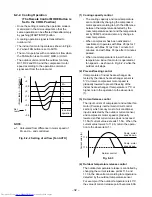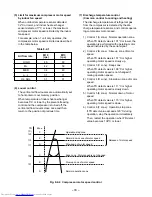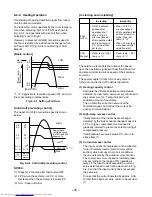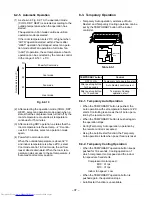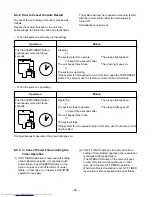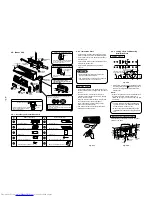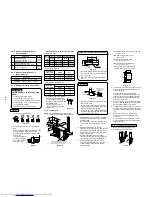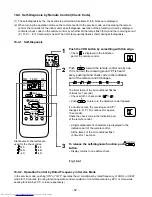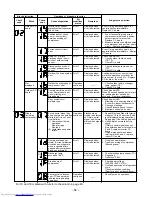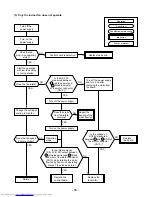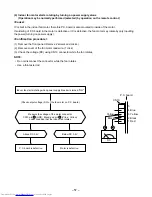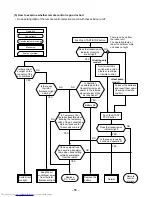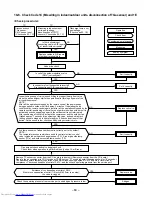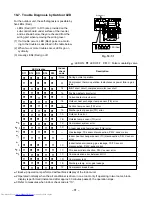
– 46 –
9-3-4. Optional Installation Parts
(Local Supply)
A
B
C
Parts name
Refrigerant piping
Liquid side : ø6,35 mm
Gas side : ø9,52 mm or ø12,7 mm
Pipe insulating material
(polyethylene foam, 6 mm thick)
Putty, PVC tapes
Q’ty
Each
one
1
Each
one
9-3-5. Optional Installation Parts
(Separate Sold)
Parts name
RB-M43RE
Reducer
(Ø12,7
→
Ø9,52)
RB-M34EE
Expander (Ø9,52
→
Ø12,7)
600
115
Suction side
Diffuser
310
76
Drain hole
9-3-6. Refrigerant Piping Connection
CAUTION
KEEP IMPORTANT 4 POINTS FOR PIPING
WORK
1. Take away dust and moisture.
(Inside of the connecting pipes)
2. Tight connection (between pipes and unit)
3. Evacuate the air in the connecting pipes
using VACUUM PUMP.
4. Check gas leak. (connected points)
Flaring
1. Cut the pipe with a pipe cutter.
Fig. 9-3-3
Drain hose sold
separately or one
on the market.
Drain nipple
Bottom plate
ø25
90˚
Obliquity
Roughness
Warp
B
+ 0
– 0,4
As shown in the figure, hang power cord
and connecting cable downward, and
take out it along piping connection port.
250mm or
more from w
all
200mm or more
600mm or more
50mm or more
from w
all
100mm or
more from w
all
Fig. 9-3-2
2. Insert a flare nut into the pipe, and flare the
pipe.
As the flaring sizes of R410A differ from those
of refrigerant R22, the flare tools newly
manufactured for R410A are recommended.
However, the
conventional tools can
be used by adjusting
projection margin of
the copper pipe.
• Projection margin in flaring : B (Unit : mm)
Rigid (Clutch type)
Outer dia.
of copper
pipe
6,35
9,52
12,7
R410A tool used
R410A
R22
0
~
0,5 (Same as left)
0
~
0,5 (Same as left)
0
~
0,5 (Same as left)
Conventional tool used
R410A
R22
1,0
~
1,5
0,5
~
1,0
1,0
~
1,5
0,5
~
1,0
1,0
~
1,5
0,5
~
1,0
Imperial (Wing nut type)
Outer dia. of
R410A
R22
copper pipe
6,35
1,5
~
2,0
1,0
~
1,5
9,52
1,5
~
2,0
1,0
~
1,5
12,7
2,0
~
2,5
1,5
~
2,0
• Flaring size : A (Unit : mm)
Outer dia. of
A
copper pipe
R410A
R22
6,35
9,1
9,0
9,52
13,2
13,0
12,7
16,6
16,2
*
In the case of flaring for R410A
with the conventional flare tool,
pull out it approx. 0,5 mm more
than that for R22 to adjust to the
specified flare size.
The copper pipe gauge is
useful for adjusting projection
margin size.
Fig. 9-3-4
9-3-7. Installation
NOTE : For installation, at least 3 dimensions
should be kept free from obstacles (walls).
Fig. 9-3-5
Outdoor
unit
10 m
or less
A
B
Valve
cover
Fixing bolt arrangement of outdoor unit
Fig. 9-3-6
• Secure the outdoor unit with the fixing bolts
and nuts if the unit is likely to be exposed
to a strong wind.
• Use ø8 mm or ø10 mm anchor bolts and
nuts.
Drainage
Fig. 9-3-7
• Install the provided drain nipple in the hole
of the bottom plate.
• Perform proper drainage processing using
a drain hose sold separately or one on the
market. (Inner diameter : 16 mm)
• Do not use an ordinary hose on the market,
because it tends to get flat and as a result,
it prevents water from draining.
1. Piping connections to the outdoor unit should
be arranged in the sequence A, B, starting
from the bottom.
(For each piping connection, the gas pipe is
on the bottom and the liquid pipe is on the
top.)
2. When multiple indoor units are to be
connected to the outdoor unit, make the ends
of the pipes and wires from each indoor unit
to ensure that they will be connected to the
outdoor unit correctly.
(Problems caused by indoor units being
connected to the outdoor unit incorrectly are
very common in multiple-unit installations.)
3. The length and height difference of the
connecting pipes between the indoor and
outdoor units must be within the ranges
indicated below.
• Total piping length : Two room Multi (A + B)
= 30 m or less
• Minimum piping length : A or B
= 2 m or more
• Maximum indoor piping length :
A or B = 20 m or less
• Maximum piping height difference :
A or B = 10 m or less
• Maximum piping / height difference
between two rooms = 10 m or less
Fig. 9-3-8
4. If the outdoor unit is to be mounred on a wall,
make sure that the platform supporting it is
sufficiently strong.
The platform should be designed and
manufactured to maintain its strength over a
long period of time, and sufficient consider-
ation should be given to ensuring that the
outdoor unit will not fall.
5. When the outdoor unit is to be mounted high
on a wall, take particular care to ensure that
parts do not fall installer is protected.
6. When doing installation work on level ground,
it is usual to wiring and piping connections to
the indoor units. And/then make to the outdoor
unit.
However if outdoor work is difficult it is
possible instead to make changes to the
procedure.
For example by making adjustments to the
wiring and piping length on the inside (rather
than the outside).
How to remove the valve cover
1. Remove a screw of the valve cover.
2. Pull the valve cover downward.
Fig. 9-3-9

